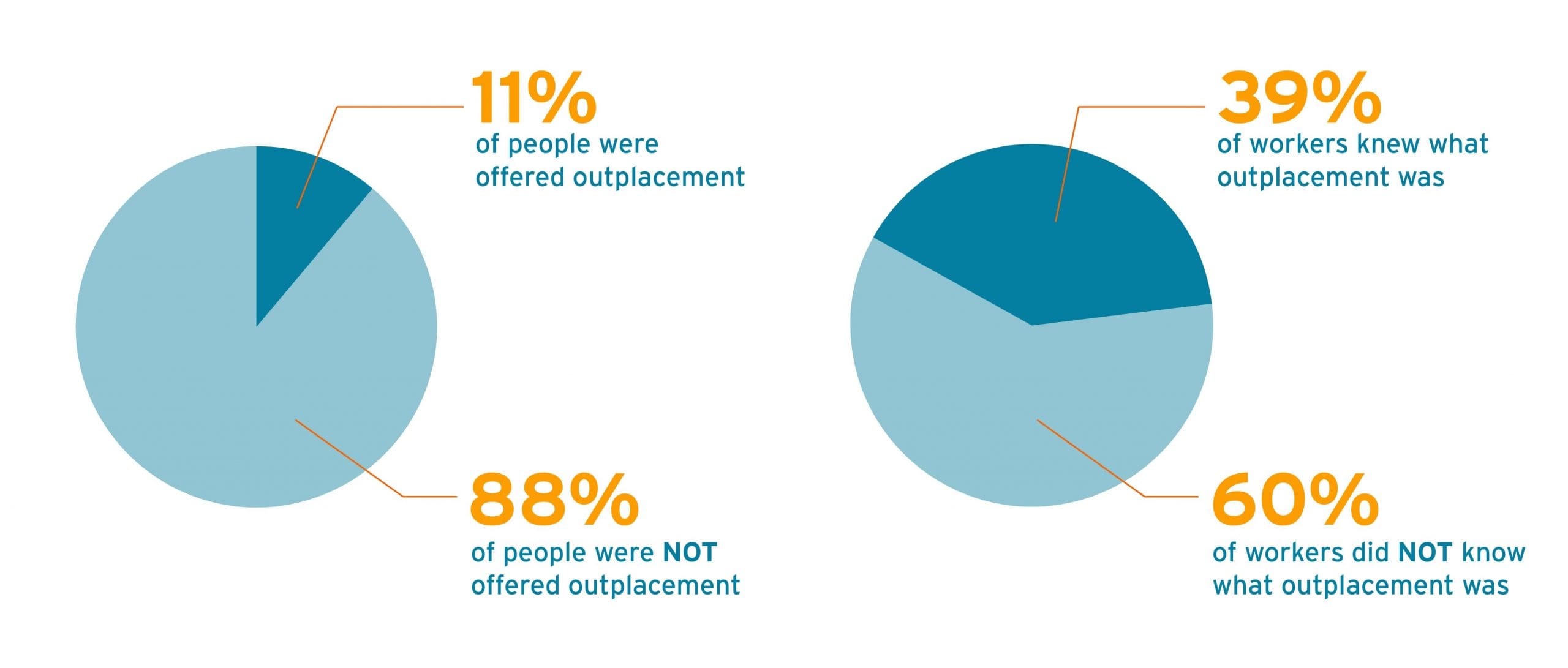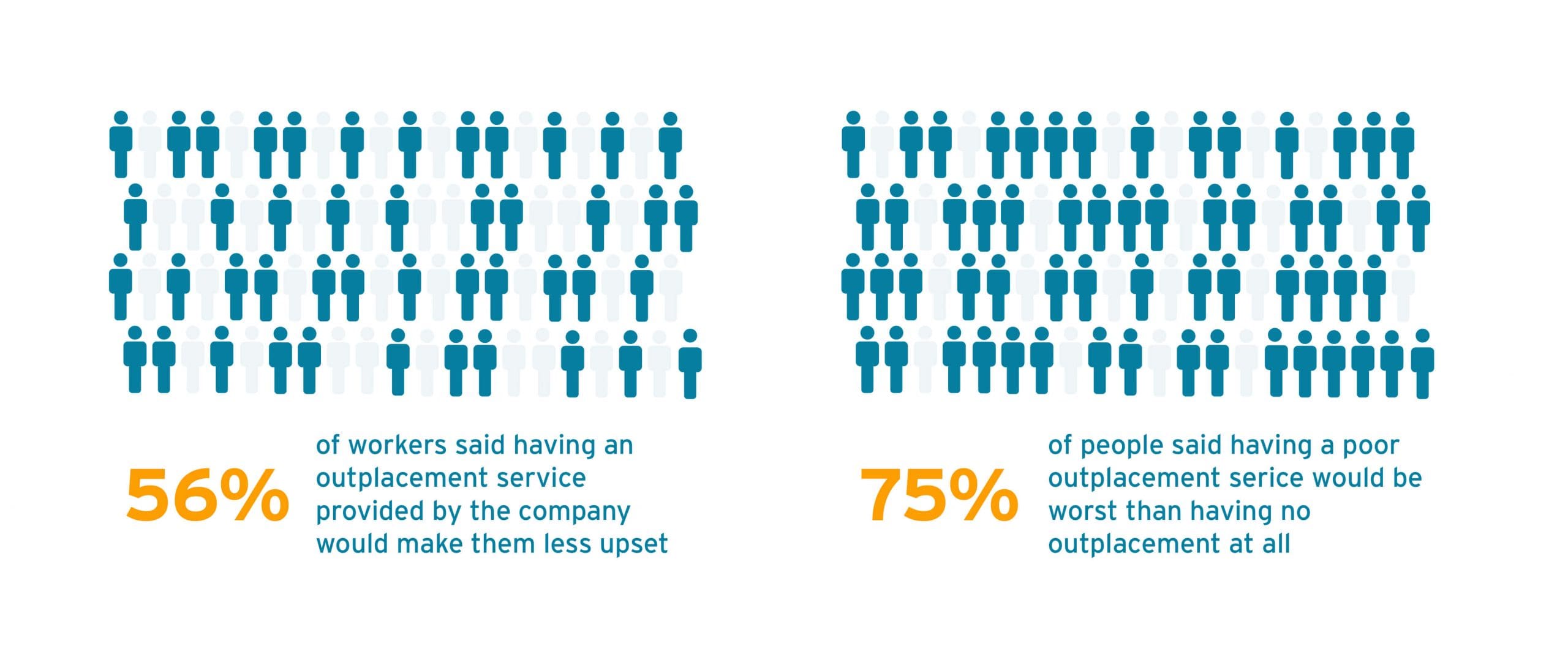
CHROs: Here’s How RIFs and Outplacement Impact Employer Brand
February 17, 2020 Written by Josh Hrala

Preparing for a RIF?
Download our Essential Guide to Handling a Layoff
Request Pricing
Compare our rates to other providers
For many CHROs, outplacement – and the entire offboarding section of the employee lifecycle – goes ignored and undervalued. However, in today’s tight talent market, employer brand management is the name of the game if organizations want to attract and retain workers for the future, suggesting that a focus on outplacement is needed.
But how does outplacement increase and protect employer branding? And, do most employees even know what outplacement is?
These are all good questions. So, to help answer them, we went straight to workers and asked them. Here’s what we found.
About The Survey
First, to collect this data, we polled over 130 workers in the US who were between the ages of 25 and 65. We did this to maintain a pool of people who may have been laid off in the past.
From there, we posed a series of questions to understand how outplacement impacts employer branding by uncovering what workers actually thought about the service in general.
One of the most interesting bits of data we observed was that a proper outplacement program is key – meaning that any old outplacement program doesn’t cut it.
In fact, a poorly structured program that doesn’t have proven results can actually be worse than not providing outplacement at all.
With all of that background out of the way, let’s dig right in.
How Common Is Outplacement?
One of the first things we found was that, despite an increased focus on employer branding and the fact that CHROs are becoming employer brand ambassadors, most people have never been offered outplacement services if they were laid off.
40 percent of workers surveyed said that they had been laid off in the past. However, only a mere 11 percent said that they had been offered outplacement. That means that a whopping 88 percent were left stranded after the event.
This is highlighted by our next finding: only 39 percent of workers said that they knew what outplacement was. 60 percent said that they didn’t.
This shows that outplacement as a benefit is underutilized. A large portion of workers were laid off, most without support, and many didn’t even know that support during a layoff was even possible because they didn’t know it existed in the first place.
These findings also show that when outplacement is offered, employers may not be doing a great job at explaining the benefits of the service to their workers. If someone doesn’t know they have this service available, how are they ever supposed to use it?
Could this be because many organizations sign up for outplacement service to merely check a box? It might. It could also be that the outplacement company doesn’t offer support or training to their corporate HR partners, such as how Careerminds offers RIF manager training.
Modern day, forward-thinking outplacement providers are much more strategic partners than they are a simple check-the-box service, working with managers and HR to conduct the layoff or RIF event during every step of the process.
Outplacement Does Make Things Better, With One Caveat
One thing that didn’t come as a surprise: people are always – obviously – upset to get laid off. Our survey asked participants to rank how upset they would be if they were suddenly let go from their current role by marking their feelings on a scale from one to 10.
On average, participants marked a seven, with many marking even higher than that (plus a few marking extremely low – most likely because they have never been laid off, or they just really dislike their current job).
We then asked them if having an outplacement service – provided for free by the company – would make them less upset. 56 percent said it would.
Still, all of these results point to a clear conclusion: outplacement helps protect employer branding by quelling some of the negativity that can crop up when someone is let go from an organization.
Poorly planned and executed layoffs tend to trigger negative emotions, which can then spread through the organization and even make their way online. This can slowly (or quickly depending on how bad the event was) erode employer brands, cause retention issues, talent management problems, and warp the public’s perspective of the company in a way that may prevent it from attracting top talent in the future.
There is just one caveat. According to our results, the level of support created by the outplacement provider has to be high or else the program can backfire.
Poor Outplacement Support Creates More Tension
Nearly 75 percent of workers said that a poor outplacement service would make them upset with their layoff, suggesting that a bad outplacement program is worse than not even offering the service at all.
These findings underline a major issue with how CHROs and organizations at large pick and choose outplacement providers.
Many companies view outplacement as a service that they merely need to have. They purchase it to ‘check a box’ like we alluded to before. However, based on these findings, that level of nonchalance when selecting a provider can backfire.
The business use-case for outplacement is to offboard workers in a way that allows them to continue their careers and lives but also to protect the organization’s brand. It’s basically another form of severance that – instead of providing legal protection in exchange for a sum of money – protects the organization from social repercussions.
These repercussions can actually be far worse than a legal battle, too. For example, if ex-workers are upset at being laid off and then have those feelings reinforced after a poorly designed outplacement experience, they will likely tell all of their friends about that bad experience. They may even take their complaints public by posting them online on sites like Glassdoor.
In our survey, we asked people to again rate on a scale of one to 10 how likely they would be to post negatively about their ex-companies online. When not offered outplacement support, most participants ranked their likelihood of posting a bad review at a five out of 10.
A bad outplacement experience caused most participants to rank their likelihood of posting a review at a five out of ten as well, though they ranked their levels of dissatisfaction a lot higher.
Providing a proper level of outplacement decreases these numbers with most participants saying that they wouldn’t write a bad review, marking their likelihood levels at a three. That’s a 40 percent decrease.
What Does All of This Mean?
People will always be upset about losing their jobs, which makes perfect sense.
However, providing outplacement can significantly decrease the chances of employees posting bad reviews and speaking badly about the company. It helps them get back on their feet and not carry around negative thoughts about the company into the future.
The real takeaway here is that poor outplacement services are basically a waste of money and can even backfire. This means that companies need to pay close attention to what firm they go with to ensure that their employees will be in good hands and actually land a job.
To pull this off, HR and organizations need to stop thinking about outplacement as a service that’s provided to merely check a box and start thinking about them as strategic partners that are there in case a layoff event may pop up.
In today’s economic climate, offboarding isn’t talked about as much as hiring is. While that makes a lot of sense because talent management is the name of the game right now, offboarding events still pop up and can actually decrease retention in survivors and also tarnish employer branding, which – in turn – makes it harder to hire top notch talent in the first place.
Offboarding impacts onboarding. They are intimately connected with one another. By ignoring the later stage of the employee lifecycle, employers are putting themselves at risk.
How to Find a Great Outplacement Provider
If all of this has you thinking that it’s high time you get a proper outplacement provider to ensure that you have all of your bases covered, you’re in luck.
Careerminds outplacement provides a high level of support to displaced workers from the moment they are notified of their layoff to the moment they find a new role. We don’t abandon people midway through their transition like traditional providers.
Participants are paired up with an experienced, dedicated career coach that will work with them one-on-one to create a customized plan of action. This is not your grandfather’s cookie cutter program that is still in use today with other providers. Their resumes will be rewritten by a professional resume writer to help their skills shine while also being optimized to defeat Applicant Tracking Systems (ATS).
On top of all of that, our participants gain access to our online learning tools to help them navigate the complicated world that is the modern job hunt, keeping them apprised of the latest job search trends to ensure they have everything they need to land their dream job.
We also help managers conduct layoff events to ensure that everything runs as smooth as possible from start to finish. In short, we are a one stop shop for all things career transition no matter what the case may be.
To learn more about how we can protect your brand, help your displaced workers find their next meaningful role, and be a strategic partner in all aspects of your business, click here.
In need of outplacement assistance?
At Careerminds, we care about people first. That’s why we offer personalized talent management solutions for every level at lower costs, globally.





